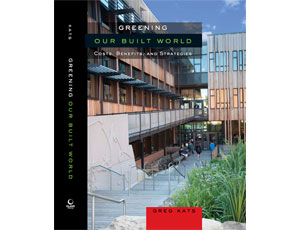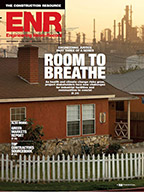Gregory Kats is Senior Director and director of climate change policy at Good Energies Inc., Washington, D.C. (www.goodenergies.com), an investment firm emphasizing renewable energy and environmental technologies. He was a principal author of Green Office Buildings: A Practical Guide to Development (ULI, 2005) and is the author of the forthcoming book Greening Our Built World: costs, benefits and strategies (Island Press, 2009; www.islandpress.org/Kats.


KATS
Tell me about your new book, Greening Our Built
World.
The official launch was in [mid-November]. It took two and a half years — a huge amount of original research went into it. It has the largest database on costs and benefits of green buildings and design. We worked with over 100 architects. We looked at 350 green buildings, 170 returned solid data. We couldn’t have gotten that three years ago. There weren’t that many buildings far along enough. We went back and kept updating into 2009.
What types of buildings did you look at?
It’s a mix. Commercial buildings, schools, mixed use, residential, higher education, healthcare, multifamily residence, labs. A couple of correctional and performing arts facilities. It’s a pretty broad spectrum, in 20 states and 20 countries.
Just what is a green building?
The greenest building is the one you don’t build. When you call it green, it means it’s �less bad� than a normal building. How much? LEED hasn’t changed enormously. It still has five categories. But more attention has been paid to site and carbon emissions issues. Performance levels have gotten higher over time. Standards get revised, and become more rigorous. And as these technologies become widely used, cost goes down. In addition, people are more likely to go for gold, not silver.
Who do you hope will this book will help?
Anybody involved with designing, financing, specifying or occupying a building. For example, if you do relatively compact conservation design—we looked at 500 residential units and 10 developments in the midwest. If you cluster residential buildings and create a lot of open space (not just set-asides), you can reduce costs by $12,000 per site.
Are schools doing enough to teach architecture students about green building?
Architectural schools are not keeping up with this new reality. They often do not teach these basic principles. You’d think one of the first courses for a student would be on solar radiation, wind energy mapping, orientation of a building to take advantage of sunshine. You could have a 30% difference before you even put the walls and windows in. Hopi Indians built buildings in harsh climates and were very smart about solar orientation, thermal mass, etc. It’s like we’ve forgotten all that and only now relearning it. The alternative is just to design dumb cookie-cutter buildings with cost being the only object.
What is the main theme of your book?
This book debunks the general public’s perception that green buildings cost more. Our data shows that’s not true. There’s also an argument that we cannot become more efficient and cut carbon emissions without hurting the economy. That’s factually wrong.Green building means greater competitiveness and jobs — that’s from the data.
Most homeowners and many builders don’t understand that buildings are the largest users of energy and sources of C02. But 45%-50% of all energy use is from buildings and building materials. Even with transportation — how you site buildings affects transportation. People would prefer to walk, have a neighborhood, a sense of community.
Who are the sponsors for your study?
The sponsors for our work include real estate organizations, AIA, APHA, NAR — these are big and fairly conservative associations. They sponsored this work in part because they want to know what is true. They’re stepping away from ideology.
What would you say to the skeptics of green building?
People who argue that we’re unable to make deep reductions in energy use are pessimistic. They believe America has lost the capability to be innovative. The technology we’re seeing leads us to believe we can get to zero-net energy buildings cost-effectively in a decade. And we can solve this problem through the free market. The market tells you to build green, healthy buildings. By 2010, 15% of all commercial buildings can be green—and 50% in 2015.



Post a comment to this article
Report Abusive Comment